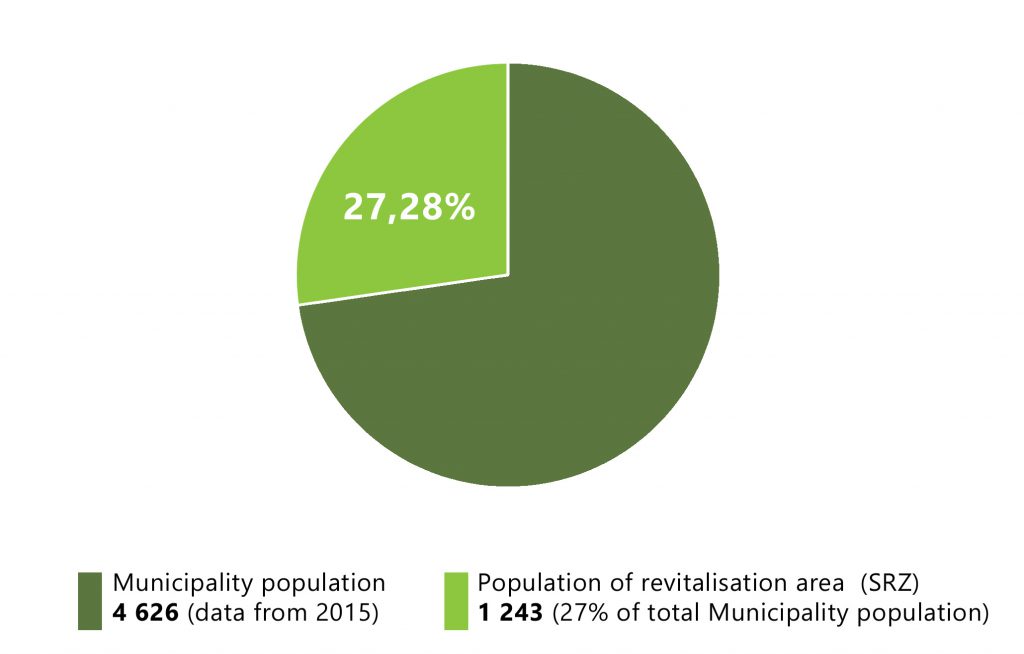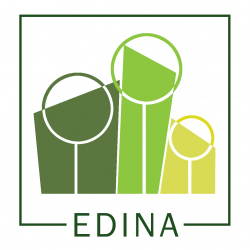

Waganiec
Period of revitalisation activities
Revitalisation activities are carried out on the basis of the Municipal Revitalization Program of Waganiec for 2016-2025, established by Resolution No. IV/50/2019 of the Waganiec City Council on March 28, 2019. The Municipal Revitalization Program is the basic document for carrying out revitalisation in the municipality. The Program was developed for the regeneration area designated by Resolution No. XXXVI/261/2017 of December 28, 2017, on the designation of the degraded area and the revitalization area. As a result of the diagnosis of degraded areas in terms of the particular concentration of negative phenomena, 3 revitalisation sub-areas were delimited: 1. Waganiec I and Waganiec II, 2. Sierzchowo and 3. Wólne. The regeneration area represents a percentage of 18.07 of the municipality’s area and is inhabited by 27.2% of the municipality’s population.
Characteristics of the revitalisation area problems
- 1st. revitalisation sub-area (Waganiec I and Waganiec II)
- Social sphere
In the revitalization sub-area, Waganiec, a number of problems in the social sphere can be identified. The sub-area is characterised by a high unemployment rate. In 2015, Waganiec recorded the highest number of unemployed people. Waganiec is also mentioned as one of the two villages with the highest number of crimes in its area, and as one of the villages with the highest percentage of people with alcohol problems. The Waganiec has also an unfavourable population structure indicating the process of ageing of society. In the regeneration area, in particular in Waganiec I, the problem of life deprivation was diagnosed, manifested by a high share of households receiving social assistance in the population of the sub-area. Moreover, the level of education in lower secondary schools located in this area is very low.
- Spatial and functional sphere
In Waganiec there are degraded areas. Both in Waganiec I and in Waganiec II there are abandoned buildings – in Waganiec I it concerns the building of the former Plant Breeding Centre, while in Waganiec II – the building of the liquidated Municipal Cooperative “Samopomoc Chłopska”. The buildings undergo gradual degradation and consequently discourage potential investors. Additionally, in the area of Waganiec II there is a devastated railway station building used by the inhabitants of the whole commune. The building is a monument from the year 1880-1890. Both the facade and the interior of the building are destroyed.
The Waganiec sub-area is the seat of the municipality and the biggest village, therefore it is the main transfer point. However, the sub-area lacks an interchange center with a bus bay, parking for cars and bicycles, or an information desk. In the village, as well as in the municipality of Waganiec, there is a lack of facilities for cultural life and social activation.
- Technical sphere
The percentage of buildings connected to the heating network is low – only 40.7% of buildings in Waganiec I have access to the heating network, while in Waganiec II none of the buildings have such access. However, it should be noted that in rural areas it is very difficult and expensive to connect all buildings to the heating network. Another problem in the technical sphere is the poor condition of roads and pavements and the lack of cycle tracks. Uneven pavements and lack of cycle paths have a negative impact on the safety of movement.
- Environmental sphere
In the municipality, the main sources of low emissions include traditional solid fuel heaters – in the Waganiec I as many as 42.0% of households use traditional solid fuel heaters, in the Waganiec II this percentage is 84.9%.
- Economic sphere
The village of Waganiec is the centre of the municipality. The administrative headquarters are located here, i.e. the Municipal Executive Office, the Municipal Social Welfare Centre the Public Library. Due to the accumulation of public institutions, Waganiec is the most frequently visited village in the commune. This sub-area had also the largest number of registered business entities in the period 2010-2015.
In the regeneration, there are several monuments registered as historical buildings (the Conservator of Monuments for Kujawsko-Pomorskie Voivodeship) i.e. a park and manor complex from the 19th century, a grain mill building from the turn of the 19th and 20th centuries and a railway station building from 1880-1890.
2. Sierzchowo (2nd revitalisation sub-area)
- Social sphere
One of the most serious and difficult problems to solve in the revitalisation area is long-term unemployment. The indicator of long-term unemployment in this village is higher than the average in the municipality. At the same time, this sub-area has a high index of burglaries. The Sierzchowo sub-area, similar to the Waganiec sub-area, the level of education in secondary schools located in this area is very low. In addition, this sub-area has a very low percentage of children aged 3-5 who attend pre-school education.
- Spatial and functional sphere
In Sierzchowie there are degraded areas. In 2008, the primary school in Sierzchów was closed down. Due to the small number of pupils, the cost of maintaining the school was too high. In the sub-area there is also a manor house from the mid-19th century, annexes, cells, and a park. The school building is currently being modernised, while the manor house is deteriorating with time. There are no places in the village where residents can improve their physical condition or socialise.
- Technical sphere
Almost all buildings (96.6%) in the village are connected to the water supply system, but none of the buildings is connected to the sanitary sewage system or district heating system. As a consequence, residents are forced to use wells and domestic sewage treatment plants or so-called septic tanks. Lack of water tightness can cause unpleasant odors and affect the condition of the soil and deep water.
- Environmental sphere
In the municipality, the main sources of low emissions include traditional solid fuel heaters – in the Sierzchowo as many as 82,8.0% of households use traditional solid fuel heaters.
- Economic sphere
The voluntary fire brigade is active in the Sierzchowo and is not only involved in safety activities but is also keen to contribute to the development of the village. Moreover, in this sub-area there are a few monuments entered in the communal register of monuments.
3. Wólne (3rd revitalisation sub-area)
- Social sphere
The sub-area of Wólne is characterized by the highest intensity of problematic phenomena in the municipality. The indicators of the ratio of burglaries in the sub-area to the total number of burglaries in the municipality and the ratio of persons of non-working age to the total population are at a level less favorable than the average in the municipality. The Wólne is also diagnosed with a high percentage (12.4%) of households receiving social assistance. Moreover, the level of education in lower secondary schools located in this area is very low.
- Spatial and functional sphere
Similarly to the area of Sierzchowo, in the sub-area of Wólne the primary school was closed down. The abandoned school building is degrading, which discourages potential investors and has a negative impact on the aesthetics of the area. Moreover, there is a municipal road leading to the school building, which is in poor technical condition. The road has no roadside, there are gaps in its surface which pose a threat to the safety of residents.
- Technical sphere
No households in the village are equipped with sewage systems. None of the buildings is connected to the district heating network. As a result, residents have to use domestic septic tanks and treatment plants and heat their water using gas or electricity. It is much easier and safer to use the network and it significantly improves the quality of life.
- Environmental sphere
In the municipality, the main sources of low emissions include traditional solid fuel heaters – in the Sierzchowo as many as 90,3% of households use traditional solid fuel heaters.
- Economic sphere
According to residents, the abandoned school building has great potential in the sub-area. After modernisation and renovation, the building can continue its former educational function. The area along the Vistula river also has potential, which after modernization could contribute to recreational and tourist development. This activity will not only provide the inhabitants with a place for rest and integration but will also increase the income of small-scale agriculture.
Description of the revitalisation area development character
In the case of the Waganiec Commune the Special Revitalisation Zone was established in the whole revitalisation area and covers three sub-areas: Waganiec consisting of two villages: Waganiec I and Waganiec II, Sierzchowo, and Wólne. All the sub-areas are characterised by the rural type of development. In all three sub-areas, there are degraded areas as well as abandoned public buildings in bad condition. The Waganiec is the center of the commune. The administrative headquarters are located here, i.e. the Municipal Executive Office, the Municipal Social Welfare Center the Public Library.
Main revitalisation activities
The main objective of the program is to transform the degraded areas for social activation. Both investment and soft projects have been planned within the programme. The implementation of 16 basic and 5 supplementary revitalisation activities was assumed.
The program shall put forward the following actions: the adaptation and extension of degraded buildings for social purposes, resulting in the creation of a Local and Environmental Development Centre, a Community Integration Centre, and a Day Care Centre. Mobility and accessibility of public transport will be improved through the construction of a transfer center.
The project also includes a number of actions aimed at supporting the long-term unemployed (e.g. creation of educational and vocational counseling places, organisation of internships in sewing plants), as well as supporting families (creation of a family and psychological counseling center) and improving the quality of education (extension of the kindergarten, organisation of additional classes for children and young people).
In view of the fact that the area has been diagnosed with a high share of households using traditional solid fuel heaters, which are a source of low emissions, actions have been planned to reduce the number of low-emission sources, including targeted subsidies for the replacement of solid fuel heat source in buildings and dwellings, organisation of a series of training sessions during which issues related to ecology will be discussed.
These activities are aimed at preventing social exclusion and professional activation, increasing environmental awareness, as well as activating young people, and disseminating a healthy lifestyle.
Establishment & tools for Special Revitalisation Zone (SRZ)
- Date of establishing the SSR: 2019;
- Area of the SSR: revitalisation area designated by Resolution No. X/115/2019 of the Waganiec of December 16, 2019. Dziennik Urzędowy Województwa Kujawsko-Pomorskiego (bydgoszcz.uw.gov.pl)
- Tools indicated in the SSR: Subsidies for construction works consisting of renovation or reconstruction, as well as conservation and restoration works for properties not listed in the register of monuments for owners or perpetual users of properties located in the SSR area;
- Level of co-financing in the SSR: 50% – works specified in the law without additional detailing;
- Link to the resolution on the SSR: http://www.edzienniki.bydgoszcz.uw.gov.pl/WDU_C/2019/7338/oryginal/akt.pdf
